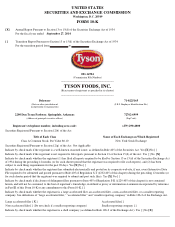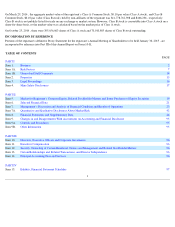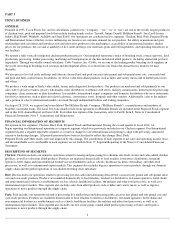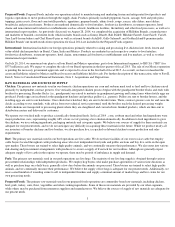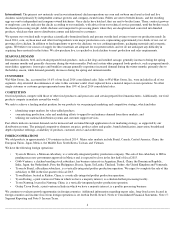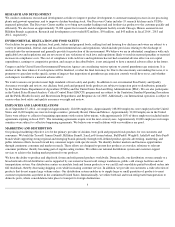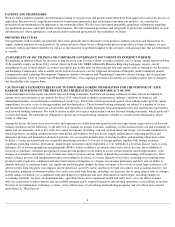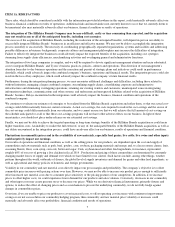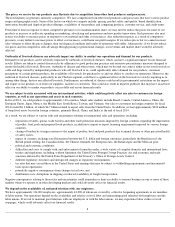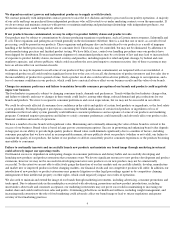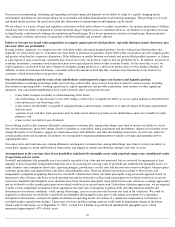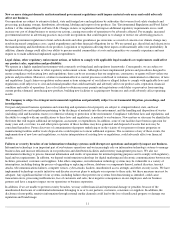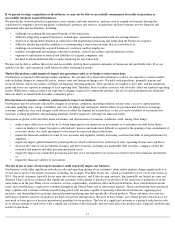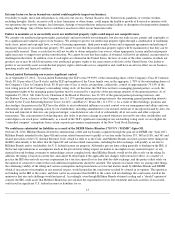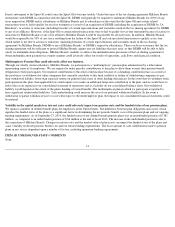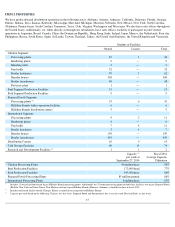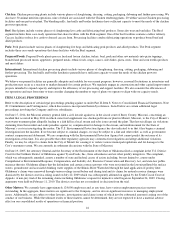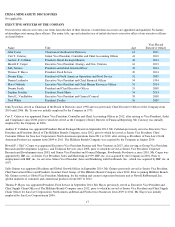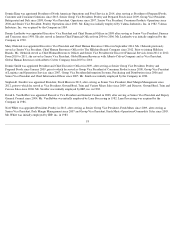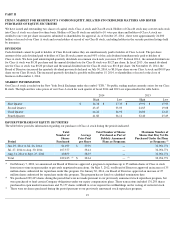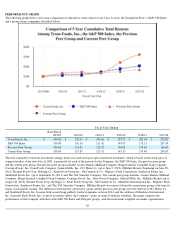Tyson Foods 2014 Annual Report Download - page 12
Download and view the complete annual report
Please find page 12 of the 2014 Tyson Foods annual report below. You can navigate through the pages in the report by either clicking on the pages listed below, or by using the keyword search tool below to find specific information within the annual report.
Our success in maintaining, extending and expanding our brand image also depends on our ability to adapt to a rapidly changing media
environment, including our increasing reliance on social media and online dissemination of advertising campaigns. The growing use of social
and digital media increases the speed and extent that information or misinformation and opinions can be shared.
We are subject to a variety of legal and regulatory restrictions on how and to whom we market our products, for instance marketing to children,
which may limit our ability to maintain or extend our brand image. Negative posts or comments about us, our brands or our products on social
or digital media could seriously damage our reputation and brand image. If we do not maintain or extend our brand image, then our product
sales, financial condition and results of operations could be materially and adversely affected.
Failure to leverage our brand value propositions to compete against private label products, especially during economic downturn, may
adversely affect our profitability.
In many product categories, we compete not only with other widely advertised branded products, but also with private label products that
generally are sold at lower prices. Consumers are more likely to purchase our products if they believe that our products provide a higher quality
and greater value than less expensive alternatives. If the difference in quality between our brands and private label products narrows, or if there
is a perception of such a narrowing, consumers may choose not to buy our products at prices that are profitable for us. In addition, in periods of
economic uncertainty, consumers tend to purchase more lower-priced private label or other economy brands. To the extent this occurs, we
could experience a reduction in the sales volume of our higher margin products or a shift in our product mix to lower margin offerings. In
addition, in times of economic uncertainty, consumers reduce the amount of food that they consume away from home at our foodservice
customers, which in turn reduces our product sales.
Our level of indebtedness and the terms of our indebtedness could negatively impact our business and liquidity position.
Our indebtedness, including borrowings under our revolving credit facility, may increase from time to time for various reasons, including
fluctuations in operating results, working capital needs, capital expenditures and possible acquisitions, joint ventures or other significant
initiatives. Our consolidated indebtedness level could adversely affect our business because:
Our revolving credit facility contains affirmative and negative covenants that, among other things, may limit or restrict our ability to: create
liens and encumbrances; incur debt; merge, dissolve, liquidate or consolidate; make acquisitions and investments; dispose of or transfer assets;
change the nature of our business; engage in certain transactions with affiliates; and enter into hedging transactions, in each case, subject to
certain qualifications and exceptions. In addition, we are required to maintain minimum interest expense coverage and maximum debt to
capitalization ratios.
Our senior notes and term loans also contain affirmative and negative covenants that, among other things, may limit or restrict our ability to:
create liens; engage in certain sale/leaseback transactions; and engage in certain consolidations, mergers and sales of assets.
An impairment in the carrying value of our goodwill or indefinite life intangible assets could negatively impact our consolidated results
of operations and net worth.
Goodwill and indefinite life intangible assets are initially recorded at fair value and not amortized, but are reviewed for impairment at least
annually or more frequently if impairment indicators arise. In assessing the carrying value of goodwill and indefinite life intangible assets, we
make estimates and assumptions about sales, operating margins, growth rates, royalty rates and discount rates based on budgets, business plans,
economic projections, anticipated future cash flows and marketplace data. There are inherent uncertainties related to these factors and
management’s judgment in applying these factors. Goodwill valuations have been calculated principally using an income approach based on
the present value of future cash flows of each reporting unit and are believed to reflect market participant views which would exist in an exit
transaction. Indefinite life intangible asset valuations have been calculated principally using relief-from-
royalty and excess earnings approaches
and are believed to reflect market participant views which would exist in an exit transaction. Under these valuation approaches, we are required
to make various judgmental assumptions about appropriate discount rates. Disruptions in global credit and other financial markets and
deterioration of economic conditions, could, among other things, cause us to increase the discount rate used in the valuations. We could be
required to evaluate the recoverability of goodwill and indefinite life intangible assets prior to the annual assessment if we experience
disruptions to the business, unexpected significant declines in operating results, divestiture of a significant component of our business or
sustained market capitalization declines. These types of events and the resulting analyses could result in impairment charges in the future,
which could be substantial. As of September 27, 2014 , we had $ 10.8 billion of goodwill and indefinite life intangible assets, which
represented approximately 45% of total assets.
10
•
it may limit or impair our ability to obtain financing in the future;
•
our credit ratings (or any decrease to our credit ratings) could restrict or impede our ability to access capital markets at desired interest
rates and increase our borrowing costs;
•
it may reduce our flexibility to respond to changing business and economic conditions or to take advantage of business opportunities
that may arise;
•
a portion of our cash flow from operations must be dedicated to interest payments on our indebtedness and is not available for other
purposes; and
•
it may restrict our ability to pay dividends.


